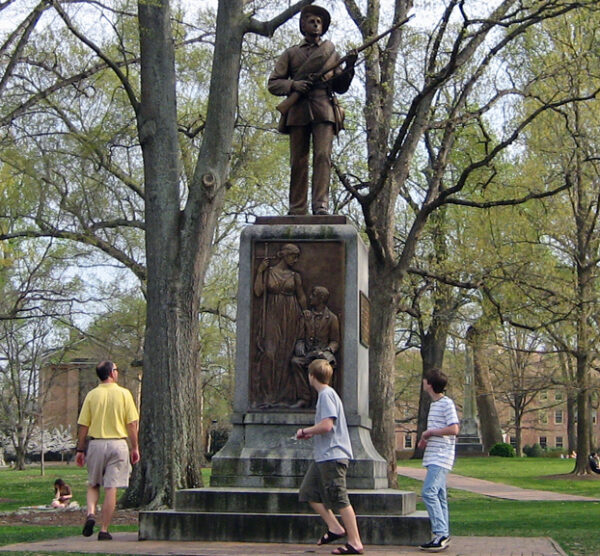Marisa Martin — the nom de wingnut of artist April Kiessling — spent her Aug. 29 WorldNetDaily column trying to defend to defend the idea of Confederate statues as art, likening activists tearing down the “Silent Sam” statue at the University of North Carolina to Roman conquerers destroying things that reminded them of the conquered:
Sam was a monument to Civil War veterans from UNC, most of whom served in the Confederacy, a body many would like to forget now. That may be understandable, although it is unalterable history. It’s also an awfully long time to carry a 158-year grudge. Other than pettiness, the real problem is insisting on erasing knowledge of the Confederacy – or anything else – from our collective unconscious.
Is this ever a good thing? Maybe it is when my team does it and not yours, or if we are the conquerors or they were the oppressors. Some type of damnatio memoriae (erasing memory of the cursed) is latent in most of us. It’s ancient, tribal, almost instinctual, and present to some extent in every tribe and nation.
Here’s proof, straight from history books and current memory:
Romans razed anything and anyone who posed a threat to military or political conquest. They first created the term damnatio memoriae, issuing official orders to erase images, names, tombs and records of the no-longer-appreciated. Mongols gutted Bagdad of its treasures until it was nothing but sand. Then there were Vandals, Vikings, Goths, Ottomans and many more.
Martin did at least concede why folks are upset enough to tear down Confederate statues:
But Silent Sam is a symbol of the Confederacy and a tortuous, evil time. It recalls division, slavery, racism and death. Complicating everything is a stream of valor and high-mindedness over it all. Men from both armies were often brave, patriotic, zealous, cultured, religious and even chivalrous. There are at least 1700 or more symbols to the Confederacy in America, and 110 have been removed already. Will obliterating all memory of the past make the core issues better or heal us of the past?
Both UNC and the Daughters of the Confederacy (sponsors) claimed to have no intention to promote racism or ill-feeling at the time. Sculptor John A. Wilson was a Canadian. By contrast, local industrialist Julian Carr, who was a Confederate veteran, gave a nasty, racially charged address at its dedication. Silent Sam’s forging may have been based in a certain amount of resentment over the War and destruction to the South, even racism. Who really knows?
“Who really knows”? Actually, a lot of people do. We can infer a lot from the fact that the statue was erected in 1913, at the height of Jim Crow, as this Forbes article details:
“Silent Sam and other Confederate monuments erected during Jim Crow represent white Southerners’ efforts — and specifically efforts by white Southern women in groups such as the United Daughters of the Confederacy — to revise Civil War history,” UNC history graduate student and Silent Sam sit-in member Jennifer Standish tells me. Nearly 50 years after the end of the Civil War, dozens of Confederate statues were erected around the U.S., but particularly in the South.
“A number of historians have shown that powerful white Southerners were creating a revisionist narrative of the Confederacy as a protector of states’ rights, Southern homes, and white Southern women in this period,” Standish points out. These new narratives ignored slavery as the cause of the war, and contributed instead to the “Jim Crow regime, which was responsible for the disenfranchisement and murder of black Southerners,” she explains.
UNC Classics Professor Jim O’Hara has also been active in understanding the history of Silent Sam and in petitioning the University administration to remove the statue. He tells me that, while Julian Carr’s racist speech is well known at this point, “less well known is what the United Daughters of the Confederacy were doing in 1913.” Specifically, in the same year that Silent Sam was dedicated, the UDC “unanimously endorsed and promoted for use in schools a history of the KKK that praised the heroic work they did to preserve white supremacy. So putting up these statues was unambiguously part of the white supremacist movement of the Jim Crow era.” Standish concurs, further noting that “these woman had racial and class privilege that allowed them – through the Silent Sam statue – to shape how all people enter and experience UNC’s campus.”
Forbes also points out that blacks were forbidden from attending UNC until 1955.
Meanwhile, Martin’s column includes a promotion for her new ebook:
Read about the odious history and current aggression of gay militants, as well as how to defend yourself from them, in Marisa Martin’s eBook, “Bitter Rainbows: Pederasts, Politics, and Hate Speech” on Amazon. Print version coming soon.
Portraying all gays as actual or potential “pedaraists” is in line with someone who freaked out over an Archie Comics storyline in which Archie died taking a bullet intended for his gay best friend. No wonder “Martin” tries to hide behind a fake name.
